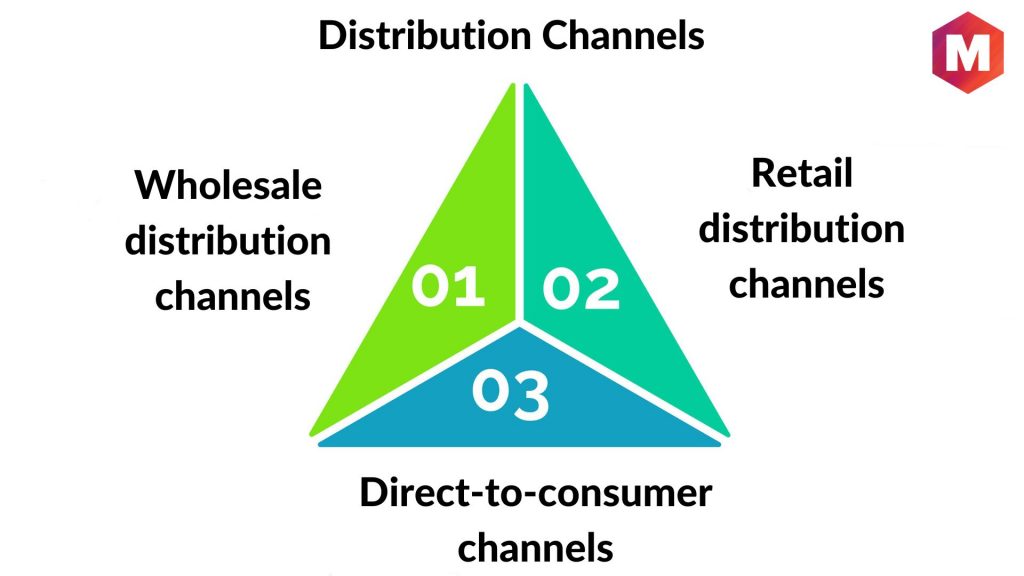Table of Contents
What Is Distribution Management?
Distribution management is a strategic business process that plans, implements, and controls the efficient movement of goods from point of origin to point of consumption to meet customers needs. It is the process of organizing and controlling the distribution of products and services to customers. It includes the distribution of physical goods, such as food and clothing, as well as the distribution of digital products, such as software and books.
Distribution management refers to the process of managing the transfer of items from a supplier to a manufacturer, then a wholesaler or retailer, and finally to an end-user. Raw good vendor management, packaging, warehousing, inventory, supply chain, logistics, and even blockchain are all involved in this complicated process.
Distribution management process is vital to any business that sells products or services, as it ensures that the right products are delivered to the right customers at the right time.
The distribution management process begins with the distribution planning stage, in which distribution managers decide which products or services to distribute, and how to distribute them. They then develop distribution strategies and plans and implement these plans through the use of effective distribution management.
Meaning of Distribution Management
Effective distribution management system is critical to a company’s ability to attract consumers and earn profits. Managing the entire distribution process effectively requires good distribution management. The more resources a business requires, the more important it is to automate distribution management.
The distribution management process is more comprehensive than moving goods from point A to point B. It also entails gathering and sharing data that can be utilized to identify key growth and competitive opportunities in the market. Most innovative businesses now employ their distribution resources to gather market knowledge, which is critical for evaluating their marketplace position.
There are two distinct types of distribution: commercial distribution (often referred to as sales distribution) and physical distribution (also known as logistics).
Customer support, shipping along with warehousing, inventory management, private trucking-fleet operations as well as packaging, receiving, and materials handling are just a few of the functions involved in distribution.
The objective is to achieve complete, on-time delivery of raw materials and components, as well as partially completed goods. The physical distribution strategy should be in line with the overall channel plan.
Why Is Distribution Management Important?
Some of the reasons behind the importance of distribution management systems are
1. Improved Customer Service
Offering goods and services to customers as per their requirements leads to improved customer service. This, in turn, helps to build a good relationship with the customers and enhances customer loyalty toward the company.
2. Enhanced Sales and Profits
An effective distribution strategy helps to reach the target audience quickly and efficiently. This results in increased sales and profits for the company.
3. Increased Efficiency
A well-managed distribution system ensures that goods are delivered to the customers on time and in good condition. This leads to increased efficiency and productivity of the company.
4. Reduced Costs
An efficient distribution system helps to reduce distribution costs by optimizing the use of resources. This leads to increased profits for the company.
5. Improved Image
A distribution system that is well-managed and efficient helps to improve the image of the company in the market. This leads to increased sales and profits for the company.
Thus, we see that distribution management is important for a company in order to survive and grow in today’s competitive market. An effective distribution strategy can help a company to gain a competitive advantage over its rivals.
So, it is essential for companies to focus on distribution management in order to stay ahead of the competition.
What Is a Distributor?
A distributor is a business that sells directly to consumers and distributes products to merchants who sell to them.
Consider, for example, a wholesaler of alcoholic beverages that provides alcohol to restaurants, grocery stores, and liquor shops.
The distribution company is the middleman between the alcohol producer and the retailer.
What Does a Distribution Manager Do?
The distribution manager is responsible for managing the distribution of products or services to customers. They develop distribution strategies and plans and implement these plans through the use of distribution channels.
A distribution manager’s duties may include:
- Planning and controlling the distribution of products or services to customers
- Developing distribution strategies and plans
- Implementing distribution plans through the use of a distribution network or different networks
- Monitoring customer demand and inventory levels to optimize customer satisfaction
- Coordinating with suppliers, manufacturers, and other stakeholders in the supply chains
- Negotiating contracts with distributors
- Managing staff and budgets
- What Is a Distribution Channel?
A distribution channel is a channel through which products or services are distributed to customers. These can be direct or indirect and may include wholesalers, retailers, distributors, and e-commerce platforms.
The distribution channel you use will depend on the type of product or service you are selling, and the needs of your customers.
For example, if you are selling a product that is perishable or has a short shelf life, you will likely use a direct distribution channel so that the product can be delivered to the customer quickly.
If you are selling a product that is not time-sensitive, you may use an indirect distribution channel, such as a retailer or e-commerce platform.
Distribution vs. Logistics
The term “logistics” refers to the thorough planning and processes involved in successfully delivering products.
Logistics refers to all of the activities involved in moving things from one place to another. Activities include supply management, temperature controls, bulk and container packaging, security, delivery routing, fleet management, shipment tracking, as well as warehousing. Logistics is an excellent example of physical distribution.
Within the logistics sector, distribution is a management method that focuses on order fulfillment through several distribution management system. The chain of agents and organizations that a good or service travels via on its journey from source to the client is known as a distribution channel.
eCommerce websites, wholesalers, retailers, and 3rd-party or independent distributors are just a few examples of distribution channels. Distribution includes activities such as consumer or commercial packaging, order fulfillment, and delivery. In other words, distribution is the process of getting products from manufacturers to customers.
Distribution Channels
1. Wholesale distribution channels
These are distribution channels in which products travel from the manufacturer to the customer through a wholesaler.
2. Retail distribution channels
These are distribution channels in which products travel from the manufacturer to the customer through a retailer.
3. Direct-to-consumer channels
These are distribution channels in which products travel directly from the manufacturer to the consumer, without going through a middleman.
Direct and Indirect Distribution Channel
The type of distribution channel you use will depend on the type of product or service you are selling, and the needs of your customers.
For example, if you are selling a product that is perishable or has a short shelf life, you will likely use a direct distribution channel so that the product can be delivered to the customer quickly.
If you are selling a product that is not time-sensitive, you may use an indirect distribution channel, such as a retailer or e-commerce platform.
The main difference between direct and indirect distribution channels is that, in a direct distribution channel, the manufacturer sells directly to the customer.
In an indirect distribution channel, there are one or more intermediaries, such as wholesalers or retailers, between the manufacturer and the customer.
Advantages of Direct Distribution Channels
- There are no middlemen, so the manufacturer can control the distribution of their products.
- The manufacturer has a direct relationship with the customer and can provide them with excellent customer service.
- The manufacturer can sell their products at a lower price because they don’t have to share profits with middlemen.
Disadvantages of Direct Distribution Channels
- The manufacturer has to invest more in distribution, as they will need to set up their own distribution channels and hire staff.
- The manufacturer may not have the reach or resources that middlemen have to get their products to customers.
Advantages of Indirect Distribution Channels
- Middlemen already have distribution channels set up, so the manufacturer doesn’t have to invest as much in distribution.
- Middlemen have the reach and resources to get the manufacturer’s products to customers that they may not have.
- Middlemen can provide valuable services to customers, such as assembly, installation, and repairs.
Disadvantages of Indirect Distribution Channels
- The manufacturer has less control over their products as they are sold through intermediaries.
- The manufacturer may have to share profits with middlemen, which can increase the price of their products.
- The manufacturer may not have a direct relationship with customers, so they may not be able to provide them with excellent customer service.
Factors of Distribution Management
1. Buyer’s demands
The distribution of products is affected by the demands of buyers. For example, if a buyer wants a product to be delivered quickly, the manufacturer will need to use a distribution channel that can provide fast delivery.
2. Shipping optimization
The distribution of products is also affected by shipping optimization. This is the process of ensuring that products are delivered to the customer the most efficiently and cost-effectively possible.
3. Other factors
Other factors that can affect distribution management include the size and location of the manufacturer, the type of product, and the regulations in the country where the product is being sold.
Distribution Management as a Marketing Function
Distribution management is a marketing function that is responsible for the distribution of products and services to customers.
The distribution manager oversees the distribution channels and ensures that products and services are delivered to customers in a timely and efficient manner.
They work with other marketing functions, such as product development, to ensure that products and services meet the needs of customers.
The distribution manager is also responsible for managing the distribution budget and ensuring that distribution costs are within the company’s budget.
What Is the Role of Distribution Management in Supply Chain Management?
The distribution manager is responsible for the distribution of products and services to customers.
They work with other marketing functions, such as product development, to ensure that products and services meet the needs of customers.
The distribution manager is also responsible for managing the distribution budget and ensuring that distribution costs are within the company’s budget.
The distribution manager works with the supply chain process to ensure that products and services are delivered to customers in a timely and efficient manner.
They also work with the logistics department to ensure that products and services are delivered to customers in a safe and secure manner.
Pros of a Distribution Management Strategy
There are several advantages of a distribution management strategy:
- It helps to ensure that products and services are delivered to customers in a timely and efficient manner.
- It helps to improve customer service by ensuring that products and services are delivered to customers in a safe and secure manner.
- It helps to reduce distribution costs by ensuring that distribution channels are used effectively.
Cons of a Distribution Management Strategy
There are several disadvantages of a distribution management strategy:
- It can be difficult to implement and manage.
- It can be costly to maintain.
- It can be time-consuming to monitor and update.
- It can be difficult to change distribution channels if they are not working effectively.
Types of Distribution Management Strategies
1. Mass
The mass distribution strategy is used when a company wants to make its products available to as many people as possible. This strategy is often used for fast-moving consumer goods (FMCG) such as food and drinks, and for products that have a wide appeal. Its upside is that it is relatively simple to implement and it can reach a large number of people. while its downside is that it can be difficult to target specific groups of people.
2. Selective
The selective distribution strategy is used when a company wants to make its products available to a specific group of people. This strategy is generally used for products that are not suitable for mass distribution, such as high-end products. The main advantages of the selective distribution strategy are that it allows a company to target specific groups of people and it can build up a relationship with its distributors. Its disadvantage is that it can be costly to implement and maintain.
3. Exclusive
The exclusive distribution strategy is used when a company wants to make its products available only through a small number of distributors. This strategy is often used for products that are high-end or niche products. Its advantage is that it allows a company to build up a relationship with its distributors and it can control the distribution of its products. Its disadvantage is that it can be difficult to reach a wide audience.
Conclusion!
A distribution management strategy is a plan that a company uses to determine how its products will be distributed to customers. There are three main types of distribution management strategies: mass, selective, and exclusive.
The type of distribution management strategy that a company chooses should be based on its business goals and the products that it sells.
A distribution management system can have several advantages, such as improved customer service and reduced distribution costs. However, it can also have several disadvantages, such as being difficult to implement and manage.
Now, what are your thoughts on distribution management? Do you think it is something that your company should implement? Let us know in the comments below!
Did you know that effective distribution management can significantly impact a company’s success?
Distribution management is continually evolving with new technologies and strategies enhancing efficiency. According to a recent study by Statista, the global logistics market was valued at approximately $6.5 trillion in 2022 and is projected to grow to $7.9 trillion by 2025. This growth highlights the increasing importance of efficient distribution management systems that not only meet customer demands but also reduce costs and improve efficiency across various sectors.
For those looking to improve their distribution strategies, one recommended tool is Oracle’s Transport Management Cloud. It allows businesses to streamline their logistics operations through advanced automation and data analytics, thereby enhancing decision-making. Reports from Gartner indicate that companies utilizing advanced distribution software can achieve up to a 20% reduction in transportation costs and improve delivery accuracy by up to 25%. Such advancements underscore the importance of leveraging technology to stay competitive in the market.
Liked this post? Check out the complete series on Distribution


